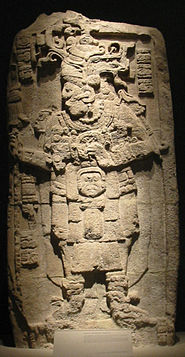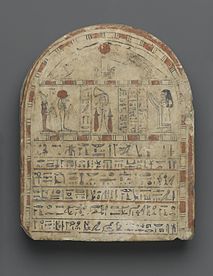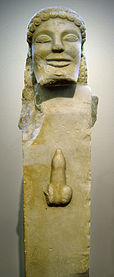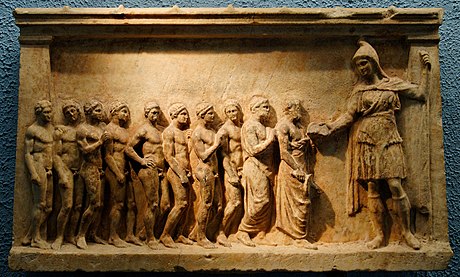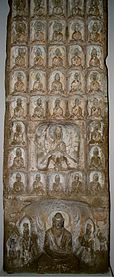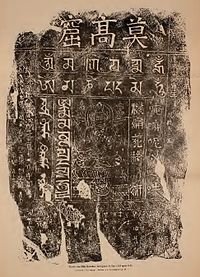Stele


Astele(/ˈstiːli/STEE-lee), fromGreekστήλη,stēlē,pluralστήλαιstēlai,[Note 1]is a stone or wooden slab, generally taller than it is wide, erected in theancient worldas amonument.The surface of the stele often has text, ornamentation, or both. These may be inscribed, carved inrelief,or painted.
Stelae were created for many reasons.[1]Gravestelae were used forfuneraryor commemorative purposes. Stelae as slabs of stone would also be used as ancientGreekandRomangovernment notices or asboundary markersto markbordersorproperty lines.Stelae were occasionally erected as memorials to battles. For example, along with other memorials, there are more than half-a-dozen steles erected on thebattlefield of Waterlooat the locations of notable actions by participants in battle.[2]
A traditional Westerngravestone(headstone, tombstone, gravestone, or marker) may technically be considered the modern equivalent of ancient stelae, though the term is very rarely applied in this way. Equally, stele-like forms in non-Western cultures may be called by other terms, and the words "stele" and "stelae" are most consistently applied inarchaeologicalcontexts to objects from Europe, the ancient Near East and Egypt,[3]China, and sometimes Pre-Columbian America.
History
[edit]
Steles have also been used to publish laws and decrees, to record a ruler's exploits and honors, to mark sacred territories or mortgaged properties, as territorial markers, as the boundary steles ofAkhenatonatAmarna,[4]or to commemorate military victories.[5]They were widely used in theancient Near East,Mesopotamia,Greece,Egypt,Somalia,Eritrea,Ethiopia,and, most likely independently, inChinaand elsewhere in theFar East,and, independently, byMesoamericancivilisations, notably theOlmec[6]andMaya.[7]

The large number of stelae, including inscriptions, surviving fromancient Egyptand inCentral Americaconstitute one of the largest and most significant sources of information on those civilisations, in particularMaya stelae.The most famous example of an inscribed stela leading to increased understanding is theRosetta Stone,which led to the breakthrough allowingEgyptian hieroglyphsto be read. An informative stele ofTiglath-Pileser IIIis preserved in theBritish Museum.Two steles built into the walls of a church are major documents relating to theEtruscan language.
Standing stones (menhirs), set up without inscriptions fromLibyainNorth AfricatoScotland,were monuments of pre-literateMegalithiccultures in theLate Stone Age.ThePictish stonesof Scotland, often intricately carved, date from between the 6th and 9th centuries.
Anobeliskis a specialized kind of stele. TheInsularhigh crossesofIrelandandGreat Britainarespecialized steles.Totem polesof North and South America that are made out of stone may also be considered a specialized type of stele.Gravestones,typically with inscribed name and often with inscribedepitaph,are among the most common types of stele seen in Western culture.
Most recently, in theMemorial to the Murdered Jews of EuropeinBerlin,the architectPeter Eisenmancreated a field of some 2,700 blank steles.[8]The memorial is meant to be read not only as the field, but also as an erasure of data that refer to memory of the Holocaust.
Egypt
[edit]
Egyptian steles (or Stelae, Books of Stone)[9]have been found dating as far back as theFirst Dynasty of Egypt.These vertical slabs of stone are used as tombstones, for religious usage, and to mark boundaries,[10]and are most commonly made of limestone and sandstone, or harder kinds of stone such as granite or diorite, but wood was also used in later times.[11][9]
Stele fulfilled several functions. There were votive, commemorative, and liminal or boundary stelae, but the largest group was the tomb stelae. Their picture area showed the owner of the stele, often with his family, and an inscription listed the name and titles of the deceased after a prayer to one, or several, of the gods of the dead and request for offerings. Less frequently, an autobiographical text provided additional information about the individual's life.[9]
In the mastaba tombs of the Old Kingdom (2686 - 2181 BC), stelae functioned as false doors, symbolizing passage between the present and the afterlife, which allowed the deceased to receive offerings. These were both real and represented by formulae on the false door.[9]
Liminal, or boundary, stele were used to mark size and location of fields and the country's borders. Votive stelae were exclusively erected in temples by pilgrims to pay homage to the gods or sacred animals. Commemorative stelae were placed in temples by the pharaoh, or his senior officials, detailing important events of his reign. Some of the most widely known Egyptian stelae include: the Kamose Stelae, recounting the defeat of theHyksos;theVictory Stele,describing the campaigns of the Nubian pharaoh Piye as he reconquered the country; the Restoration Stele of Tutankhamun (1336 - 1327 BC), detailing the religious reforms enacted after the Amarna period; and theMerneptah Stele,which features the first known historical mention of theIsraelites.In Ptolemaic times (332 - 30 BC), decrees issued by the pharaoh and the priesthood were inscribed on stelae in hieroglyphs, demotic script and Greek, the most famous example of which is theRosetta Stone.[11][9]
Urartu
[edit]Urartiansteles were freestanding stone obelisks that served a variety of purposes, erected in theIron Agekingdom which existed in theArmenian Highlandsof modernArmenia,TurkeyandIranbetween the 9th and 6th centuries BC. Some were located within temple complexes, set within monumental rock-cut niches (such as the niche of the Rock ofVan,discovered byMarrandOrbeliin 1916[12]), or erected beside tombs. Others stood in isolated positions and, such as theKelashin Stele,had a commemorative function or served as boundary markers. Although sometimes plain, most bore a cuneiform inscription that would detail the stele's function or the reasons for its erection. The stele from Van's "western niche" contained annals of the reign ofSarduri II,with events detailed yearly and with each year separated by the phrase "For the GodHaldiI accomplished these deeds ".[12]Urartian steles are sometimes found reused as ChristianArmeniangravestones or asspoliainArmenian churches-Marancisuggests this reuse was a deliberate desire to capitalize on the potency of the past.[13]Some scholars have suggested Urartian steles may have influenced the development of the Armeniankhachkar.[14]
Greece
[edit]
Greek funerary markers, especially in Attica, had a long and evolutionary history in Athens. From public and extravagant processional funerals to different types of pottery used to store ashes after cremation, visibility has always been a large part of Ancient Greek funerary markers in Athens. Regarding stelai (Greek plural of stele), in the period of the Archaic style in Ancient Athens (600 BC) stele often showed certain archetypes of figures, such as the male athlete.[15]Generally their figures were singular, though there are instances of two or more figures from this time period.[16]Moving into the 6th and 5th centuries BC, Greek stelai declined and then rose in popularity again in Athens and evolved to show scenes with multiple figures, often of a family unit or a household scene. One such notable example is the Stele of Hegeso. Typically grave stelai are made of marble and carved in relief, and like most Ancient Greek sculpture they were vibrantly painted.[17]For more examples of stelai, the Getty Museum's published Catalog of Greek Funerary Sculpture is a valuable resource[18]
China
[edit]

Steles (Chinese:bēiBi) have been a major medium of stone inscription in China, the earliest examples dating from theQin dynasty.[19]Chinese steles are generally rectangular stone tablets upon whichChinese charactersare carvedintagliowith a funerary, commemorative, or edifying text. They can commemorate talented writers and officials, inscribe poems, portraits, or maps, and frequently contain thecalligraphyof famous historical figures.[20]In addition to their commemorative value, many Chinese steles are regarded as exemplars of traditional Chinese calligraphic scripts, especially theclerical script.[21]
Chinese steles from before theTang dynastyare rare: there are a handful from before theQin dynasty,roughly a dozen from theWestern Han,160 from theEastern Han,and several hundred from theWei,Jin,Northern and Southern,andSuidynasties.[22]During the Han dynasty, tomb inscriptions (Mộ chí,mùzhì) containing biographical information on deceased people began to be written on stone tablets rather than wooden ones.[23]
Erecting steles at tombs or temples eventually became a widespread social and religious phenomenon. Emperors found it necessary to promulgate laws, regulating the use of funerary steles by the population. TheMing dynastylaws, instituted in the 14th century by its founder theHongwu Emperor,listed a number of stele types available as status symbols to various ranks of thenobilityand officialdom: the top noblemen and mandarins were eligible for steles installed on top of astone tortoiseand crowned withhornless dragons,while the lower-level officials had to be satisfied with steles with plain rounded tops, standing on simple rectangular pedestals.[24]
Steles are found at nearly every significant mountain and historical site in China. TheFirst Emperormade five tours of his domain in the 3rd century BC and hadLi Simake seven stone inscriptions commemorating and praising his work, of which fragments of two survive.[23]One of the most famous mountain steles is the 13 m (43 ft) high stele atMount Taiwith the personal calligraphy ofEmperor Xuanzong of Tangcommemorating his imperial sacrifices there in 725.[23]
A number of such stone monuments have preserved the origin and history of China's minority religious communities. The 8th-century Christians ofXi'anleft behind theXi'an Stele,which survived adverse events of the later history by being buried underground for several centuries. Steles created by theKaifeng Jewsin 1489, 1512, and 1663, have survived the repeated flooding of theYellow Riverthat destroyed their synagogue several times, to tell us something about their world.China's Muslimhave a number of steles of considerable antiquity as well, often containing both Chinese and Arabic text.
Thousands of steles, surplus to the original requirements, and no longer associated with the person they were erected for or to, have been assembled in Xi'an'sStele Forest Museum,which is a popular tourist attraction. Elsewhere, many unwanted steles can also be found in selected places in Beijing, such as Dong Yue Miao, the Five Pagoda Temple, and the Bell Tower, again assembled to attract tourists and also as a means of solving the problem faced by local authorities of what to do with them. The long, wordy, and detailed inscriptions on these steles are almost impossible to read for most are lightly engraved on white marble in characters only an inch or so in size, thus being difficult to see since the slabs are often 3m or more tall.
There are more than 100,000 surviving stone inscriptions in China. However, only approximately 30,000 have been transcribed or had rubbings made, and fewer than those 30,000 have been formally studied.[23]
Maya stelae
[edit]Maya stelae were fashioned by theMaya civilizationof ancientMesoamerica.They consist of tall sculpted stone shafts or slabs and are often associated with low circular stones referred to as altars, although their actual function is uncertain.[26]Many stelae were sculpted in low relief,[27]although plain monuments are found throughout the Maya region.[28]The sculpting of these monuments spread throughout the Maya area during theClassic Period(250–900 AD),[26]and these pairings of sculpted stelae and circular altars are considered a hallmark of Classic Maya civilization.[29]The earliest dated stela to have been foundin situin the Maya lowlands was recovered from the great city ofTikalinGuatemala.During the Classic Period almost every Maya kingdom in the southern lowlands raised stelae in its ceremonial centre.[28]
Stelae became closely associated with the concept ofdivine kingshipand declined at the same time as this institution. The production of stelae by theMayahad its origin around 400 BC and continued through to the end of the Classic Period, around 900, although some monuments were reused in thePostclassic(c. 900–1521). The major city ofCalakmulinMexicoraised the greatest number of stelae known from anyMaya city,at least 166, although they are very poorly preserved.
Hundreds of stelae have been recorded in the Maya region,[30]displaying a wide stylistic variation.[28]Many are upright slabs oflimestonesculpted on one or more faces,[28]with available surfaces sculpted with figures carved in relief and withhieroglyphic text.Stelae in a few sites display a much more three-dimensional appearance where locally available stone permits, such as atCopánandToniná.[28]Plain stelae do not appear to have been painted nor overlaid withstuccodecoration,[31]but most Maya stelae were probably brightly painted in red, yellow, black, blue and other colours.[32]
Cambodia
[edit]
Khmer inscriptions are a corpus of post-5th century historical texts engraved sometimes on steles, but more generally on materials such as stone and metal ware found in a wide range of mainlandSoutheast Asia(Cambodia,Vietnam,ThailandandLaos) and relating to the Khmer civilization. The study of Khmer inscriptions is known as Khmerepigraphy.
Khmer inscriptions are the only local written sources for the study of ancient Khmer civilization.
More than 1,200 Khmer inscriptions of varying length have been collected. There was an 'explosion' of Khmer epigraphy from the seventh century, with the earliest recorded Khmer stone inscription dating from 612 AD atAngkor Borei.
Ireland
[edit]
Oghamstones are vertical grave and boundary markers, erected at hundreds of sites in Ireland throughout the first millennium AD, bearing inscriptions in thePrimitive Irishlanguage. They have occasionally been described as "steles."[33][34][35]
Horn of Africa
[edit]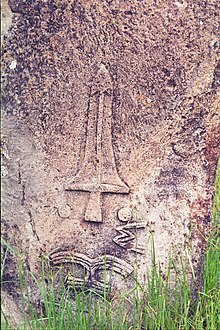
TheHorn of Africacontains many stelae. In the highlands ofEthiopiaandEritrea,theAxumiteserected a number of large stelae, which served a religious purpose in pre-Christian times. One of these granite columns is the largest such structure in the world, standing at 90 feet.[36]
Additionally,Tiyais one of nine megalithic pillar sites in the central Gurage Zone of Ethiopia. As of 1997, 118 stele were reported in the area. Along with the stelae in the Hadiya Zone, the structures are identified by local residents asYegragn Dingayor "Gran's stone", in reference to ImamAhmad ibn Ibrahim al-Ghazi(Ahmad "Gurey" or "Gran" ), ruler of theAdal Sultanate.[37]
The stelae at Tiya and other areas in central Ethiopia are similar to those on the route betweenDjibouti Cityand Loyada inDjibouti.In the latter area, there are a number of anthropomorphic and phallic stelae, which are associated with graves of rectangular shape flanked by vertical slabs. The Djibouti-Loyada stelae are of uncertain age, and some of them are adorned with a T-shaped symbol.[38]
Near the ancient northwestern town ofAmudinSomalia,whenever an old site had the prefixAwin its name (such as the ruins ofAwbareandAwbube[39]), it denoted the final resting place of a local saint.[40]Surveys by A.T. Curle in 1934 on several of these important ruined cities recovered variousartefacts,such aspotteryandcoins,which point to a medieval period of activity at the tail end of the Adal Sultanate's reign.[39]Among these settlements, Aw Barkhadle is surrounded by a number of ancient stelae.[41]Burial sites nearBuraolikewise feature old stelae.[42]
Notable steles
[edit]

- Stele of Vespasian
- Code of Hammurabi
- Gwanggaeto Stele
- King Ezana's Stela
- Kul Tigin
- Lemnos stela
- Lapis Niger
- Mesha Stele
- Naram-Sin
- Xi'an Stele
- Pig stele of Edessa
- Stone of Terpon
- The Doctorate steles at theTemple of Literature, Hanoi
- The Ram Khamhaeng stele
- Ukrainian stone stelae
- In Africa:
- In the Western Hemisphere:
- Mexico:Tres Zapotes Stela C,Izapa Stela 5,La Mojarra Stela 1
- Guatemala: Stela 14 fromPiedras Negras
- Honduras: Stela H fromCopan
- Peru:Raimondi Stela
Gallery
[edit]This sectioncontains an unencyclopedic or excessive gallery of images. |
-
Egyptian grave stela of Nehemes-Ra-tawy,c. 760–656 BC
-
Aneolithic Sardinianmenhir(c. 2500BC) recovered atLaconiand assigned to the Abealzu-Filigosa culture
-
Thelunetteof theCode of Hammurabi(c. 1750BC), depicting thekingreceiving his law from the sun godShamash
-
TheMerneptah Stele(c. 1200BC), engraved on the back of a reused stele ofAmenhotep III's, with the earliest mention of thename Israel
-
A Buddhist Stele fromChina,Northern Weiperiod, built sometime after 583
-
TheXi'an Stele(781) records the success of themissionaryAlopeninTangChina inChineseandSyriac.It is borne by aBixiandforbidden to travel abroad.
-
Rodney's Stone,a slab cross from Early MedievalScotland
-
Sueno's Stone(c. 9thcentury) inForres,Scotland,displaying efforts at modern preservation of thePictish stones
-
Tombstones(funerary stelae) at theCommon Burying Ground and Island Cemetery,Newport, Rhode Island.Typical inscriptions include the names of the deceased interred under the stones.c. 18th centuryand later.
-
A disc shaped gravestone orhilarriin Bidarray, western Pyrenees,Basque Country,featuring typical geometric and solar forms, as it was the custom since the period previous to Roman times
See also
[edit]- Cantabrian stelae
- Headstone
- Kurgan stelae
- Monumental inscription
- Obelisk
- Runestone
- Stećci
- Stele of the Vultures
Notes
[edit]- ^The plural in English is sometimesstelai/ˈstiːlaɪ/STEE-lyebased on direct transliteration of the Greek, sometimesstelaeorstelæ/ˈstiːliː/STEE-leebased on theinflection of Greek nouns in Latin,and sometimes anglicized tosteles(/ˈstiːliːz/STEE-leez).) or occasionallystela(pl.:stelasorstelæ) when derived fromLatin.
References
[edit]- ^Reich, Ronny; Katzenstein, Hannah (1992). "Glossary of Archaeological Terms". In Kempinski, Aharon; Reich, Ronny (eds.).The Architecture of Ancient Israel.Jerusalem: Israel Exploration Society. p. 312.ISBN978-965-221-013-5.
Stele: Upright slab of stone, worked or unworked, erected for memorial or cuitic purposes. Sometimes inscribed or decorated.
- ^Commons:Category:Battle of Waterloo steles;Timmermans, D. (7 March 2012)."Waterloo Campaign".The British monuments.
- ^Collon
- ^MemoirsBy Egypt Exploration Society Archaeological Survey of Egypt 1908, p. 19
- ^e.g., Piye's victory stela (M. Lichtheim,Ancient Egyptian LiteratureVol 3, TheUniversity of California Press1980, pp. 66ff) or Shalmaneser's stela at Saluria (Boardman,op. cit.,p. 335)
- ^Pool,op. cit.,p. 265
- ^Pool,op. cit.,p. 277
- ^Till (2005): 168.
- ^abcdeStrudwick, Helen (2006).The Encyclopedia of Ancient Egypt.New York: Sterling Publishing Co., Inc. pp. 214–223.ISBN978-1-4351-4654-9.
- ^Dunn, Jimmy."The Stelae of Ancient Egypt".Tour Egypt.Retrieved8 July2014.
- ^abAllen, Thomas George (1936)."Egyptian Stelae in Field Museum of Natural History".Biodiversity Heritage Library.RetrievedMay 4,2020.
- ^abG. Azarpay,Urartian Art and Artifacts,1968, p32.
- ^C. Maranci,Vigilant Powers: Three Churches of Early Medieval Armenia,2015, p177-182.
- ^C. Maranci,Vigilant Powers: Three Churches of Early Medieval Armenia,2015, footnote 311 on page 198.
- ^Caskey, L. D. "An Archaic Greek Grave Stele in Boston." American Journal of Archaeology 15.3 (1911): 293. CrossRef. Web.
- ^Robinson, Edward. "An Archaic Greek Grave Monument." The Metropolitan Museum of Art Bulletin 8.5 (1913): 94. CrossRef. Web.
- ^Campbell, Gordon. The Grove Encyclopedia of Classical Art and Architecture. Oxford; New York: Oxford University Press, 2007. Print.
- ^Grossman, Janet Burnett. Greek Funerary Sculpture: Catalogue of the Collections at the Getty Villa. Los Angeles: JPaul Getty Museum, 2001. Print.
- ^Endymion Wilkinson,Chinese History: A Manual(Cambridge, Massachusetts: Harvard-Yenching Institute, 6th edition (2022): 81.
- ^Wilkinson (2022): 81.
- ^"The Stele of Mount Hua Temple at The West Alp".Vincent's Calligraphy.Retrieved2017-05-16.
- ^Wilkinson (2022): 81.
- ^abcdWilkinson (2022): 81.
- ^de Groot, Jan Jakob Maria (1892),The Religious System of China,vol. II, Brill Archive, pp. 451–452.
- ^Martin & Grube 2000,p. 113.
- ^abMiller 1999,p. 9.
- ^Fuente et al. 1999,p. 187.
- ^abcdeStuart 1996,p. 149.
- ^Stewart 2009,p. 8.
- ^Stuart 1996,p. 158.
- ^Goudsward, David (5 May 2014).Ancient Stone Sites of New England and the Debate Over Early European Exploration.McFarland.ISBN9781476604862– via Google Books.
- ^elisabetta."connemara.irish".www.connemara.irish.Archived fromthe originalon 2017-10-26.Retrieved2017-10-25.
- ^Menninger, Karl (10 April 2013).Number Words and Number Symbols: A Cultural History of Numbers.Courier Corporation.ISBN9780486319773– via Google Books.
- ^Brockman, Norbert (2011).Encyclopedia of Sacred Places, Volume 1.ABC-CLIO. p. 30.ISBN978-1598846546.
- ^Fukui, Katsuyoshi (1997).Ethiopia in broader perspective: papers of the XIIIth International Conference of Ethiopian Studies Kyoto 12-17 December 1997.Shokado Book Sellers. p. 370.ISBN4879749761.Retrieved23 December2014.
- ^Fattovich, Rodolfo (1987)."Some remarks on the origins of the Aksumite Stelae"(PDF).Annales d'Éthiopie.14(14): 43–69.doi:10.3406/ethio.1987.931.Archived fromthe original(PDF)on 2015-09-24.Retrieved7 September2014.
- ^abLewis, I.M. (1998).Saints and Somalis: Popular Islam in a Clan-based Society.The Red Sea Press. p. 90.ISBN978-1-56902-103-3.
- ^G.W.B. Huntingford, "The Town of Amud, Somalia",Azania,13(1978), p. 184
- ^Briggs, Phillip (2012).Somaliland.Bradt Travel Guides. p. 98.ISBN978-1-84162-371-9.
- ^"National Museums".Somali Heritage and Archaeology.Retrieved13 October2013.
Bibliography
[edit]- Boardman, John, ed.The Cambridge Ancient History,Part 1, 2nd Edition, (ISBN978-0-521-22496-3)
- Collon, Dominique, et al. "Stele."Grove Art Online.Oxford Art Online. Oxford University Press. Web. 3 Jun. 2015.Subscription required
- Miller, Mary(1999).Maya Art and Architecture.London, UK and New York, US:Thames & Hudson.ISBN0-500-20327-X.OCLC41659173.
- Pool, Christopher A.Olmec Archaeology and Early Mesoamerica.Cambridge University Press,2007 (ISBN978-0-521-78312-5)
- Sharer, Robert J.; Loa P. Traxler (2006).The Ancient Maya(6th ed.). Stanford, California, US:Stanford University Press.ISBN0-8047-4817-9.OCLC57577446.
- Stewart, Daniel Moroni (2009).Parentage Statements and Paired Stelae: Signs of Dynastic Succession for the Classic Maya(PDF)(Master's thesis). Provo, Utah, US:Brigham Young University.Retrieved2016-02-09.
- Stuart, David(Spring–Autumn 1996). "Kings of Stone: A Consideration of Stelae in Ancient Maya Ritual and Representation".RES: Anthropology and Aesthetics.29–30 (29/30 The Pre-Columbian). Cambridge, Massachusetts, US:President and Fellows of Harvard Collegeacting through thePeabody Museum of Archaeology and Ethnology:148–171.doi:10.1086/RESvn1ms20166947.JSTOR20166947.S2CID193661049.
- Till, Karen E.The New Berlin: Memory, Politics, Place.University of Minnesota Press,2005
- Wilkinson, Endymion (2022),Chinese History: A New Manual(6 ed.), Cambridge, Massachusetts:Harvard University Asia Center,ISBN9780674260184.
External links
[edit]- The Cesnola collection of Cypriot art: stone sculpture,a fully digitized collection catalog from The Metropolitan Museum of Art Libraries, which contains material on steles
- Egyptian Stelae in Field Museum of Natural History,documentation of collection 1936

